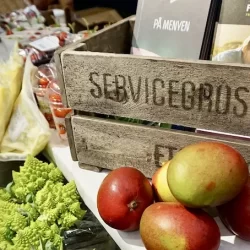Servicegrossistene frees up time to spend on tactical and strategic procurement issues

How can you manage the supply chain effectively in the face of strongly fluctuating demand? Blue Ridge’s supply chain software has helped Norwegian foodservice wholesaler Servicegrossistene to significantly improve its forecast reliability and inventory levels. During a recent Webinar Wednesday, Managing Director Jan van der Burg provided insight into the improvements achieved: “We now have more time for supplier negotiations.”
By Marcel te Lindert
On the futures market, the price of coffee has roughly doubled in the past year. Companies that see such price increases coming can take early action in anticipation. “We prefer to buy more coffee than we need for the next three weeks so that we can benefit from a better margin. But if you have to manage the whole assortment manually, you lack the time to make such tactical and strategic purchasing decisions,” stated Jan van der Burg, Managing Director of Servicegrossistene.
Servicegrossistene is owned by 17 local wholesalers in Norway who operate jointly as a national foodservice wholesaler. Until recently, one of those 17 wholesalers had four buyers who were responsible for the total assortment, including beverages and fresh produce. “Every morning their time was taken up by placing orders with our suppliers to ensure there was sufficient stock. Then they spent every afternoon correcting those orders, because it turned out that they needed a little more or a little less of each item,” said Van der Burg.
From four buyers to two
The four buyers were aware that their approach was inefficient and they tried to learn from all the ordering errors, but the day-to-day operation consumed all their time and attention. The turning point came following a pilot with Blue Ridge’s supply chain software. “The wholesaler succeeded in changing its approach from reactive into proactive. The buyers now only spend 20% of their time checking the assortment and correcting orders.”
Thanks to the pilot, the company has managed to free up two of its four buyers for other tasks. The two remaining buyers now have more time for error prevention and for tactical and strategic purchasing decisions. “They have succeeded in improving their competencies. We now also have time to negotiate with suppliers,” added Van der Burg, who is pleased with Blue Ridge’s software. “We’ve realized that it’s better to adapt our approach to fit with the system rather than the other way around, and that it’s important to set aside enough time to get to grips with all the jargon.”
Service level heading towards 99%
The good results from the pilot gave Servicegrossistene sufficient reason to implement the software throughout the whole company, including at the 16 other affiliated wholesalers. Despite the pandemic, the implementation was completed in record time. Even the fact that the 40-plus users had to receive training via Microsoft Teams didn’t have a detrimental effect. “At the pilot wholesaler, we saw the forecasting reliability improve after just a few months and we’re now seeing the same trend across the entire group. The only deviation was in the week that Norway’s hospitality industry was allowed to reopen. The software doesn’t yet know how to pick up on that signal,” said Van der Burg humourously.
The managing director of Servicegrossistene presented graphs showing that the service levels of the other wholesalers, just as at the pilot company, are heading towards 99%. “This is how we set ourselves apart. However, customers such as large corporate canteens are happy as long as our service level is above 97.5%, so I sometimes wonder whether our service level is actually too high,” Van der Burg explained. “In fact, our actual service level is even higher, because if we can’t supply Brand A’s rice most customers will settle for Brand B. But that’s not reflected in the statistics.”
From 22% overstock to 5%
The biggest improvement has been with respect to overstock, which stood at 22% at the pilot company before the software implementation. It has now been reduced to 5%. “Less overstock means not only less waste, but also a longer shelf life for our products. Additionally, it frees up more space in our warehouses, which is important because our annual growth has been stable at 7 to 8% for years. Plus less stock means less need for financing from our bank.”
At group level, overstock has fallen from 40% to 28%, which still seems high. Van der Burg explained that it is partly due to the distances in Norway; the wholesalers in the far north need higher levels of safety stock, simply because it takes two days to replenish them from the central cross-dock centre in Oslo. “Despite this, we are now seeing rapid decreases in the overstock. It should be possible to reduce it down to 14%, but that’s not the most important goal. Ultimately, what matters most is our customer service.”
Planning per channel
Now that the software is working well everywhere, Servicegrossistene is in a position to set up integrated business planning (IBP) at a central level. “For the first time we can now do the planning for all 17 wholesalers – not only at product level, but also per location or per channel. We discovered how important it is to be able to plan per channel during the pandemic, when the government ordered hospitality businesses such as bars and restaurants to close but hospital canteens and fast-food outlets continued to operate. The software now makes it easy for us to change the index for hotels and restaurants from 100 to 5 and see the impact. We’re more responsive than before.”









